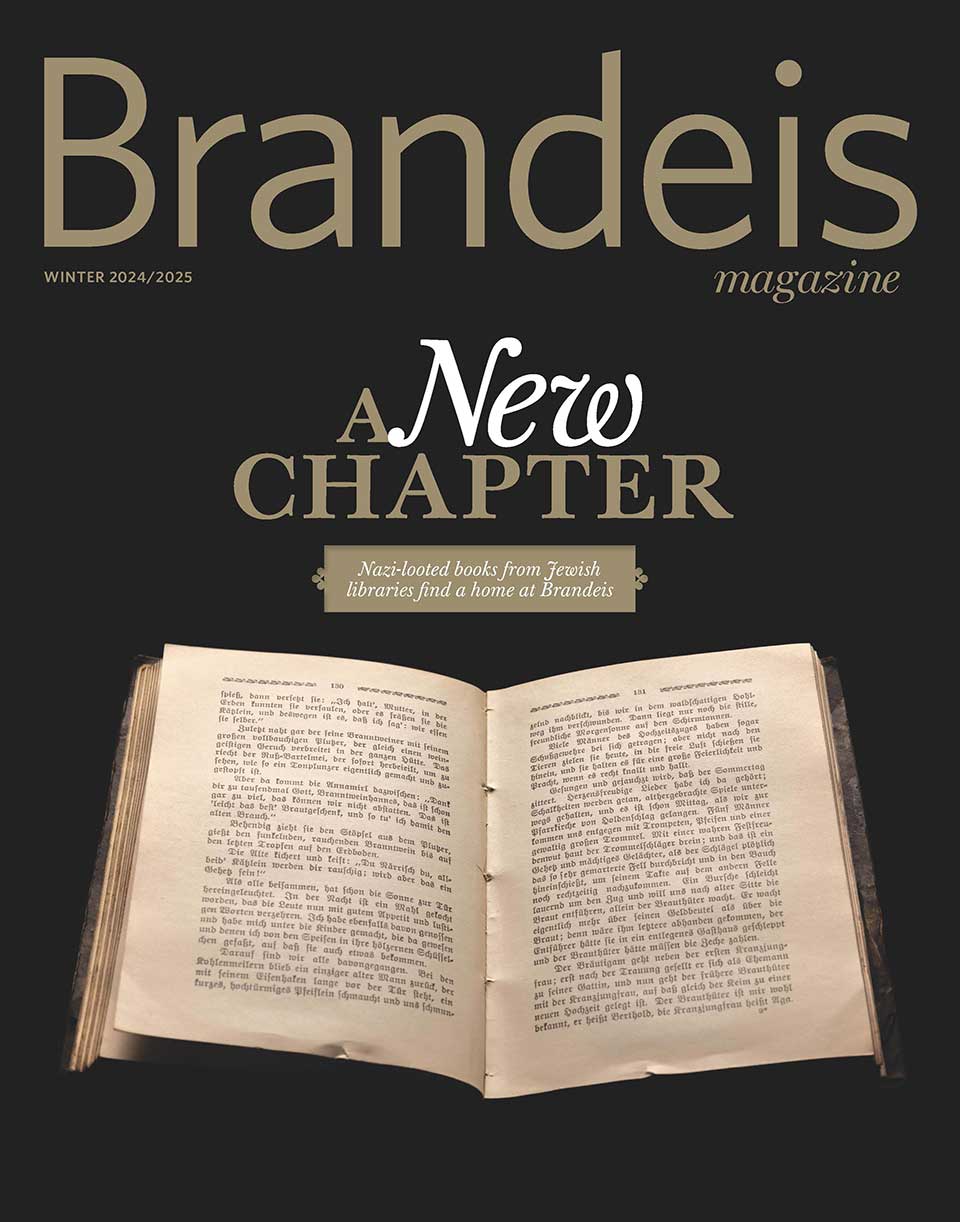The Vatican, Il Duce and the Jews
An extraordinary book explains in disturbing detail the history-altering relationship between Pope Pius XI and Mussolini.
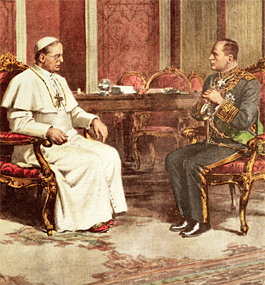
Copyright Alfredo Dagli Orti / The Art Archive / Corbis
WILLING PARTNERS: Mussolini meets with Pius XI in the pope's study in 1932.
by David I. Kertzer, PhD’74
It was an unholy alliance.
In the 1920s and ’30s, Pope Pius XI and Benito Mussolini relied on and used each other in their quest to preserve and protect their respective institutions, the Catholic Church and Italy’s Fascist government. Eight decades later, Brown University professor David I. Kertzer, PhD’74, has written a book that reveals exactly how deep and damaging those ties were, drawing on materials found in recently opened Vatican files.
Kertzer’s book, “The Pope and Mussolini: The Secret History of Pius XI and the Rise of Fascism in Europe,” has been dubbed “a sophisticated blockbuster” by historian Joseph Ellis. Even before its publication this winter, the volume, written with a you-are-there clarity and urgency, was stirring up excitement and debate. An excerpt reprinted in the pages that follow, the book’s dramatic prologue, offers a sense of why. But first, in an introduction written especially for Brandeis Magazine, Kertzer describes how he came to his galvanizing topic.
__________
Looking back now on the unlikely path that led me to write “The Pope and Mussolini,” I realize the book would never have been written had I not ended up at Brandeis in 1969. I arrived on campus right out of college, a new doctoral student in anthropology.
Though I was already interested in the links between politics and religion, I had no idea I would spend my adult life studying Italy. But not long after I arrived in Waltham, the anthropology department chair, Alex Weingrod, who had himself worked in Sardinia, suggested I consider Italy for my dissertation research. The home of both the Vatican and the largest Communist party outside of a Communist country, it offered a fascinating case for studying how people dealt with competing calls of political party and church. So in 1971 I set out with my new wife, Susan, to spend a year doing fieldwork in Bologna, which eventually led to my first book, “Comrades and Christians.”
Having hardly ever stepped foot in a church in my life, I found attending multiple Masses every week, regularly interviewing priests and church activists, and plumbing the riches of the parish archives a revelation. After completing my dissertation in 1973, I kept returning to Italy — any excuse would do — continuing to examine Italian politics and embarking on various historical projects.
Curiously, it was Italy’s Jews who first led me to work in the Vatican archives and triggered my interest in papal politics. A colleague of mine, Steve Hughes, an American historian of Italy, asked me offhandedly at a conference in the early 1990s whether I had ever heard of the Mortara case. In 1858, Edgardo Mortara, a 6-year-old child of Jewish parents in Bologna, was seized on orders of the Inquisitor. He had — or so it was thought — been secretly baptized by a Christian servant girl and therefore could not remain in a Jewish family. I became fascinated with this largely buried story, which led me to Pope Pius IX, the Vatican Secret Archives and eventually to my book, “The Kidnapping of Edgardo Mortara.”
Perhaps because of the anthropologist’s credo that you shouldn’t study your own kind, I had never thought I would work on a Jewish topic. Yet my interest in Italy is rooted in my early childhood and is very much linked to Italian Jewry. My father, Morris, a rabbi, was a chaplain with the U.S. troops who landed in Anzio in January 1944 and drove the German army from Rome the following June. One of the most memorable stories I heard as a child was of the first service held in Rome’s synagogue a few days following liberation, a service my father conducted with Rome’s chief rabbi.
In retrospect, my turn toward an interest in the popes and the Jews, inspired by an offhand remark about a little Jewish boy in Bologna, might not have been quite so unexpected after all. Not only had my father been a Jewish chaplain in Italy during the war, but shortly after the war he became the director of the new program in interreligious affairs at the American Jewish Committee in New York City. He would come home from his various trips talking with great enthusiasm of his meetings with priests and ministers as, in the wake of the Holocaust, they worked together to create a more positive view of Jews in America’s churches.
A little over a decade ago, Pope John Paul II announced a plan to open the Vatican archives for the papacy of Pius XI (1922-39). The prospect of being among the first to read the thousands of newly available documents was exciting, since historians continue to dispute just what happened behind Vatican walls during those dramatic years.
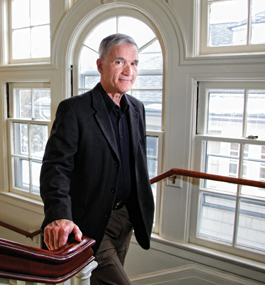
Mike Lovett
David I. Kertzer, PhD'74
page 2 of 4
Among the controversies, none has been more heated than that surrounding Italy’s draconian “racial” laws, introduced in 1938. Overnight, Jewish children were ejected from public schools, Jews were thrown out of their jobs, and Italians were taught that their Jewish neighbors were conspiring against them. According to the most widely believed account of these events, the pope and the Vatican fought heroically against the laws and, in fact, helped turn Italian opinion against them. Others have disputed these claims, arguing that Italy’s racial laws in fact relied heavily on the backing of the Catholic Church.
Now, with the opening of the Vatican archives, it would be possible to get to the bottom of the story. What I discovered turned out to be even more surprising than I had ever suspected.
For instance, when it became clear in August 1938 that Mussolini was planning to introduce a series of restrictive laws aimed at Italy’s Jews, Pius XI sent Father Pietro Tacchi Venturi, his personal envoy, to the dictator to come to an understanding. Until the Vatican archives were opened, the only hint of this deal came from the writings of a Jesuit scholar who, a half century ago, had been given access to the files. But, apparently embarrassed by what he found, or perhaps finding it impossible to believe, he dismissed the key document, proclaiming it was not what it appeared to be.
Now we have access not only to the original document — a formal agreement between Mussolini and Tacchi Venturi, acting on the pope’s behalf — but also to various documents describing the series of meetings between Tacchi Venturi and the pope that led up to the deal. In exchange for some concessions to benefit Catholic organizations, the Vatican promised it would make no protest against the upcoming anti-Semitic laws.
A deeper plunge into the Vatican archives — along with the wealth of materials I found in the Fascist archives, including hundreds of secret police reports by Fascist informants in the Vatican — revealed yet another dramatic episode, which happened just months after the Vatican’s deal with the Fascists. Pius XI, aging and infirm, was growing increasingly upset with Mussolini, not least for his ever-closer embrace of Hitler. To the great alarm of the men around the pope, it looked as though he might turn against the dictator. This they could not tolerate.
So “The Pope and Mussolini” begins with a prologue — which I am delighted that Brandeis Magazine is reprinting here — that transports the reader back to these last days of Pius XI. In other words, the book begins with a glimpse of the end of my story, or almost the end, for I could not stop before telling something of where all this led. Documents from the Fascist archives and from German diplomatic papers reveal how relieved Fascist and Nazi leaders were at the news of the pope’s death. And how frantically they labored behind the scenes to ensure that Pius XI’s successor would be a man with whom they could work.
The whole story is one many would prefer had remained buried under Vatican lock and key.
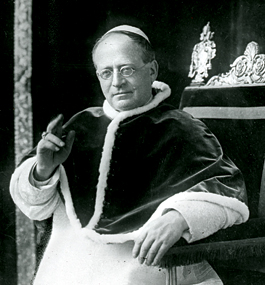
Courtesy Caulfield McKnight Collection, University of Michigan
THE MOUNTAINEER POPE: Pius XI in 1925.
page 3 of 4
Prologue to “The Pope and Mussolini”
Rome, 1939
Ailing, elderly and having barely survived circulatory failure the previous year, Pope Pius XI begged God to grant him a few more days. He sat at his desk in his third-floor Vatican office in his white robe, a cane resting against the wall nearby. The rusted compass and barometer from his climbs to Italy’s highest Alpine peaks lay on one side, a reminder of days long past. An old tuning fork remained in a drawer. It had been years since he had last taken it out. Proud of his singing voice and eager that his sense of pitch not desert him, he had practiced when he could, but only when he was sure no one was listening. Now, knowing the end was near, he went through each drawer, making sure his papers were in order.
For years, the pope had enjoyed good health, and observers had marveled at his punishing schedule. He had insisted on knowing every detail of Vatican affairs and deciding everything of any significance. Now every day was a challenge; every step caused pain. At night, unable to sleep, he lay awake, his legs throbbing from varicose veins, his asthma making breathing a struggle, and, worst of all, plagued by the feeling that something had gone terribly wrong.
In the daytime, light streamed into his office through the three windows that overlooked St. Peter’s Square. But now it was night, and his small desk lamp cast a yellow glow over the sheets in front of him. The Lord, he thought, had kept him alive for a reason. He was God’s vicar on earth. He could not die before saying what had to be said.
The pope had summoned all of Italy’s bishops to Rome to hear his final message. The gathering was to be held in a week and a half in St. Peter’s Basilica, on Feb. 11, 1939. It would mark the 10th anniversary of the Lateran Accords, the historic agreement that Pius XI had struck with Italy’s dictator, Benito Mussolini, ending decades of hostility between Italy and the Roman Catholic Church. With that agreement, the separation of church and state that had marked modern Italy from its founding 68 years earlier came to an end. A new era began, the church a willing partner of Mussolini’s Fascist government.
Seventeen years earlier, in 1922, Achille Ratti, freshly appointed cardinal, had been the surprising choice to succeed Pope Benedict XV. He took the name Pius XI. Later that same year, amid widespread violence, Mussolini, the 39-year-old Fascist leader, became Italy’s prime minister. Since then, the two men had come to depend on each other. The dictator relied on the pope to ensure Catholic support for his regime, providing much-needed moral legitimacy. The pope counted on Mussolini to help him restore the church’s power in Italy. Now, with pen in hand, thinking back over these years, Pius felt a deep regret. He had allowed himself to be led astray. Mussolini seemed to think he was a god himself, and he had embraced Adolf Hitler, a man the pope despised for undermining the church in Germany and championing a pagan religion of his own. The painful scene Rome had witnessed the previous spring haunted him: A sea of red and black Nazi flags had blanketed the city, as the German Führer passed through its historic streets in triumphal procession.
Two months after Hitler’s visit, Mussolini shocked the world by proclaiming that Italians were a pure, superior race. Although Jews had lived in Rome since before the time of Jesus, they were now officially deemed a noxious foreign people. The pope was horrified. Why, he asked in a public audience, was Italy’s leader so eager to imitate the Führer? The question enraged Mussolini, for nothing upset him more than being called Hitler’s stooge. The men of the pope’s inner circle rushed to repair the damage. More comfortable with authoritarian regimes than with democracies, and fearful of losing the many privileges that Mussolini had granted the church, they thought the pope was getting reckless in his old age. He had already alienated the Nazi leaders; now, they worried, he was putting the Vatican’s ties to Mussolini’s Fascist regime at risk.
At his headquarters on the other side of Rome’s Tiber River, Mussolini raged against the pope. If Italians still went to mass, it was only because he had told them to. If it weren’t for him, anticlerics would be running wild through Italy’s streets, sacking churches and forcing castor oil down the throats of cowering priests. If every classroom and courtroom had a crucifix on its wall, if priests taught religion in all of Italy’s public schools, it was because Mussolini had ordered it. If generous state funds were being used to support the church, it was because he had willed it, all in an effort to craft a mutually beneficial understanding between his Fascist government and the Vatican.
Pius stayed up late on the night of Jan. 31, as he had the previous night, drafting his remarks for the gathering of bishops. The once hearty, barrel-chested “mountaineer” pope was emaciated, his formerly full face deeply wrinkled and shrunken. But it was clear to all who saw him how determined he was to give that speech. He did not want to die before warning the bishops that Fascist spies were everywhere, including the halls of the church. It would be his last chance to denounce Mussolini’s embrace of Nazi racism.
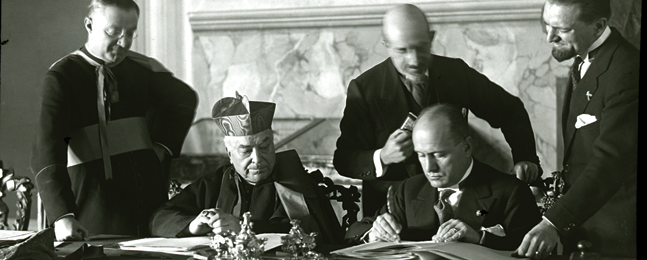
Courtesy Caulfield McKnight Collection, University of Michigan
ENDING THE ENMITY: Cardinal Secretary of State Pietro Gasparri and Mussolini sign the Lateran Accords, Feb. 11, 1929.
page 4 of 4
In the week remaining before the speech, however, the pope’s remaining reserve of strength began to fail him. Unable to stand, he took to bed. Cardinal Eugenio Pacelli, who as secretary of state was second-in-command at the Vatican, begged him to postpone the gathering. The pope would not hear of it and ordered the Vatican daily newspaper to report that he was in good health. On Feb. 8, worried that he might not be strong enough to give the speech in three days’ time, he ordered the Vatican printing office to make a copy of it for each bishop. The following night, his condition worsened, and in the early morning hours of Feb. 10 his breathing became more labored. Attendants, careful not to disturb the white skullcap on his head, fastened an oxygen mask over his mouth. At 4 a.m., they roused Cardinal Pacelli. The cardinal rushed to the pope’s bedside, then fell to his knees to pray. His eyes reddened with tears.
Lying on his simple iron bed, rapidly fading, Pius XI soon took his last feeble breath. God had not granted his final request. The bishops would see him next not in St. Peter’s Basilica but in the nearby Sistine Chapel, where, on the afternoon of Feb. 10, his ruined body was placed on a raised platform. To those who had known him in his prime, he was barely recognizable. It was as if someone else lay there, under Michelangelo’s frescoed ceiling, wearing the pope’s white silk cassock and red ermine-lined cap.
Across the Tiber, Mussolini greeted news of the pope’s death with a grunt of relief, eager that the papal wake not interfere with his next coupling with Clara Petacci, his green-eyed young mistress. But one last concern remained. Over the years, he had put in place an extensive network of spies in the Vatican and read their reports eagerly. In recent days, they had warned him that the pope planned to give an inflammatory anniversary speech denouncing Mussolini’s anti-Semitic campaign and his ever-tightening ties to the German Führer. If the text got out now, he worried, it might yet do damage, a prophetic papal plea from the grave.
There was one man, thought the dictator, in a position to help. He contacted Cardinal Pacelli, who in his role as chamberlain was now in charge of everything Pius had left behind, including the handwritten pages piled on his desk and the stacks of freshly printed booklets ready for distribution to the bishops. Mussolini wanted all copies of the speech destroyed.
He had reason to think that Pacelli would oblige him. Hailing from a prominent Roman family closely linked to popes for generations, Pacelli had for the last months lived in fear that the pope would antagonize Mussolini. Too much, he thought, was at stake. Yes, he owed a great deal to the pope who had made him secretary of state and had promoted him in so many ways. But he felt he had an even greater responsibility to protect the church. He ordered the pope’s desk cleared, the printed copies of his speech seized.
Three weeks later, a large crowd waited impatiently in St. Peter’s Square as the cardinals met in conclave. At the appearance of the telltale ribbon of white smoke wafting from the Apostolic Palace, a cheer went up. “Habemus papam,” announced the cardinal deacon from the balcony perched above the main entrance of St. Peter’s. Soon a tall, thin, bespectacled figure, newly clothed in white papal robe and bejeweled tiara, strode out to give his blessing. Eugenio Pacelli would take the name Pius XII, honoring the man at whose bedside he had recently wept.
From “The Pope and Mussolini: The Secret History of Pius XI and the Rise of Fascism in Europe,” by David I. Kertzer (Random House, 2014), reprinted by permission of the publisher. Kertzer, the Paul Dupee Jr. University Professor of Social Science and professor of anthropology and Italian studies at Brown University, is also the author of “The Kidnapping of Edgardo Mortara,” a finalist for the National Book Award in 1997.
